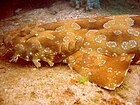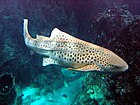Carpet shark: Difference between revisions
removed Category:Orders of fishes; added Category:Fish orders using HotCat |
Nolifeguy21 (talk | contribs) No edit summary |
||
| Line 16: | Line 16: | ||
}} |
}} |
||
The '''carpet sharks''' are an [[order (biology)|order]], '''Orectolobiformes''', of [[shark]]s, so called because many members have ornate patterns reminiscent of carpets. Sometimes the term "carpet shark" is used interchangeably with [[wobbegong]], which are a subgroup of the order. |
The '''carpet sharks''' are an [[order (biology)|order]], '''Orectolobiformes''', of [[shark]]s, so called because many members have ornate patterns reminiscent of carpets. Sometimes the term "carpet shark" is used interchangeably with [[wobbegong]], which are a subgroup of the order. They tend to live and swim close to the bottom of the ocean because they like darker areas. |
||
Carpet sharks have two [[dorsal fin]]s, without spines, and a small mouth that is forward of the eyes. Many have [[barbel (anatomy)|barbel]]s and small [[gill slit]]s, with the fifth slit overlapping the fourth. The upper lobe of the [[caudal fin]] tends to be mostly in line with the body, while the lower lobe is poorly developed. |
Carpet sharks have two [[dorsal fin]]s, without spines, and a small mouth that is forward of the eyes. Many have [[barbel (anatomy)|barbel]]s and small [[gill slit]]s, with the fifth slit overlapping the fourth. The upper lobe of the [[caudal fin]] tends to be mostly in line with the body, while the lower lobe is poorly developed. |
||
Revision as of 21:42, 10 July 2013
| Carpet sharks Temporal range:
| |
|---|---|

| |
| Whale shark | |
| Scientific classification | |
| Kingdom: | |
| Phylum: | |
| Class: | |
| Subclass: | |
| Superorder: | |
| Order: | Orectolobiformes Applegate, 1972
|
| Families | |
|
See text | |
The carpet sharks are an order, Orectolobiformes, of sharks, so called because many members have ornate patterns reminiscent of carpets. Sometimes the term "carpet shark" is used interchangeably with wobbegong, which are a subgroup of the order. They tend to live and swim close to the bottom of the ocean because they like darker areas.
Carpet sharks have two dorsal fins, without spines, and a small mouth that is forward of the eyes. Many have barbels and small gill slits, with the fifth slit overlapping the fourth. The upper lobe of the caudal fin tends to be mostly in line with the body, while the lower lobe is poorly developed.
Classification
The order is small, with only around 43 species in seven families in 13 genera:
Order Orectolobiformes
- Family Brachaeluridae Applegate (Blind sharks)
- Genus Brachaelurus Ogilby, 1908
- Brachaelurus waddi (Bloch & J. G. Schneider, 1801) (Blind shark)
- Genus Heteroscyllium Regan, 1908
- Heteroscyllium colcloughi (Ogilby, 1908) (Bluegrey carpetshark)
- Genus Brachaelurus Ogilby, 1908
- Family Ginglymostomatidae Gill, 1862 (Nurse sharks)
- Genus Ginglymostoma J. P. Müller & Henle, 1837
- Ginglymostoma cirratum Bonnaterre, 1788 (Nurse shark)
- Genus Nebrius Rüppell, 1837
- Nebrius ferrugineus (Lesson, 1831) (Tawny nurse shark)
- Genus Pseudoginglymostoma Dingerkus, 1986
- Pseudoginglymostoma brevicaudatum (Günther, 1867) (Short-tail nurse shark)
- Genus Ginglymostoma J. P. Müller & Henle, 1837
- Family Hemiscylliidae Gill, 1862 (Bamboo sharks)
- Genus Chiloscyllium J. P. Müller & Henle, 1837
- Chiloscyllium arabicum Gubanov, 1980 (Arabian carpetshark)
- Chiloscyllium burmensis Dingerkus & DeFino, 1983 (Burmese bamboo shark)
- Chiloscyllium caerulopunctatum Pellegrin, 1914 (Bluespotted bamboo shark)
- Chiloscyllium griseum J. P. Müller & Henle, 1838 (Grey bamboo shark)
- Chiloscyllium hasseltii Bleeker, 1852 (Hasselt's bamboo shark)
- Chiloscyllium indicum (J. F. Gmelin, 1789) (Slender bamboo shark)
- Chiloscyllium plagiosum (Anonymous, referred to Bennett, 1830) (Whitespotted bamboo shark)
- Chiloscyllium punctatum J. P. Müller & Henle, 1838 (Brownbanded bamboo shark)
- Genus Hemiscyllium J. P. Müller & Henle, 1837
- Hemiscyllium freycineti (Quoy & Gaimard, 1824) (Indonesian speckled carpetshark)
- Hemiscyllium galei G. R. Allen & Erdmann, 2008[2]
- Hemiscyllium hallstromi Whitley, 1967 (Papuan epaulette shark)
- Hemiscyllium henryi G. R. Allen & Erdmann, 2008[2]
- Hemiscyllium michaeli G. R. Allen & Dudgeon, 2010[3] (Milne Bay epaulette shark)
- Hemiscyllium ocellatum (Bonnaterre, 1788) (Epaulette shark)
- Hemiscyllium strahani Whitley, 1967 (Hooded carpetshark)
- Hemiscyllium trispeculare J. Richardson, 1843 (Speckled carpetshark)
- Genus Chiloscyllium J. P. Müller & Henle, 1837
- Family Orectolobidae Gill, 1896 (Wobbegong sharks)
- Genus Eucrossorhinus Regan, 1908
- Eucrossorhinus dasypogon (Bleeker, 1867) (Tasselled wobbegong)
- Genus Orectolobus Bonaparte, 1834
- Orectolobus floridus Last & Chidlow, 2008 (Floral banded wobbegong)
- Orectolobus halei Whitley, 1940.[4]
- Orectolobus hutchinsi Last, Chidlow & Compagno, 2006.[5] (Western wobbegong)
- Orectolobus japonicus Regan, 1906 (Japanese wobbegong)
- Orectolobus leptolineatus Last, Pogonoski & W. T. White, 2010 (Indonesian wobbegong)
- Orectolobus maculatus (Bonnaterre, 1788) (Spotted wobbegong)
- Orectolobus ornatus (De Vis, 1883) (Ornate wobbegong)
- Orectolobus parvimaculatus Last & Chidlow, 2008 (Dwarf spotted wobbegong)
- Orectolobus reticulatus Last, Pogonoski & W. T. White, 2008 (Network wobbegong)
- Orectolobus wardi Whitley, 1939 (Northern wobbegong)
- Genus Sutorectus Whitley, 1939
- Sutorectus tentaculatus (W. K. H. Peters, 1864) (Cobbler wobbegong)
- Genus Eucrossorhinus Regan, 1908
- Family Parascylliidae Gill, 1862 (Collared carpet sharks)
- Genus Cirrhoscyllium H. M. Smith & Radcliffe, 1913
- Cirrhoscyllium expolitum H. M. Smith & Radcliffe, 1913 (Barbelthroat carpetshark)
- Cirrhoscyllium formosanum Teng, 1959 (Taiwan saddled carpetshark)
- Cirrhoscyllium japonicum Kamohara, 1943 (Saddle carpetshark)
- Genus Parascyllium Gill, 1862
- Parascyllium collare E. P. Ramsay & Ogilby, 1888 (Collared carpetshark)
- Parascyllium elongatum Last & Stevens, 2008 (Elongate carpetshark)
- Parascyllium ferrugineum McCulloch, 1911 (Rusty carpetshark)
- Parascyllium sparsimaculatum T. Goto & Last, 2002 (Ginger carpetshark)
- Parascyllium variolatum (A. H. A. Duméril, 1853) (Necklace carpetshark)
- Genus Cirrhoscyllium H. M. Smith & Radcliffe, 1913
- Family Rhincodontidae (J. P. Müller & Henle, 1839) (Whale sharks)
- Genus Rhincodon A. Smith, 1828
- Rhincodon typus A. Smith, 1828 (Whale shark)
- Genus Rhincodon A. Smith, 1828
- Family Stegostomatidae Gill, 1862 (Zebra sharks)
- Genus Stegostoma J. P. Müller & Henle, 1837
- Stegostoma fasciatum (Hermann, 1783) (Zebra shark)
- Genus Stegostoma J. P. Müller & Henle, 1837
| Family | Image | Common name | Genera | Species | Description |
|---|---|---|---|---|---|
| Brachaeluridae | 
|
Blind sharks | 2 | 2 | Blind sharks are found in shallow coastal waters up to 110 metres (360 ft) deep off the eastern coast of Australia.[1] They are distinguished by the presence of long barbels, large spiracles, and groove around the nostrils. They have two dorsal fins, placed close together on the back, and a relatively short tail. Blind sharks feed on small fish, cuttlefish, sea anemones, and crustaceans. The female retains the eggs in her body until they hatch (ovoviviparity), during which time the embryos feed solely on the egg yolk.[1] Blind sharks are not blind; the name came because it closes its eyes when taken out of water.[1] There are only two species. |
| Ginglymostomatidae | 
|
Nurse sharks | 3 | 3 | Nurse sharks have long tails and distinctive mouths which are far ahead of the eyes and before the snout (sub-terminal), an indication of the bottom-dwelling (benthic) nature of these sharks. Also present on the lower jaw are two fleshy barbels, chemosensory organs which help the nurse sharks find prey hidden in the sediments. Common in shallow, tropical and subtropical waters, these sharks are sluggish and docile bottom-dwellers. Nurse sharks typically attack humans only if directly threatened. The largest species can reach a length of 4.3 metres (14 ft). |
| Hemiscylliidae | 
|
Bamboo sharks | 2 extant 4 extinct | 16 extant 6 extinct | Bamboo sharks, sometimes called longtail carpet sharks, are distinguished by a relatively long snout with subterminal nostrils.[6] They are relatively small sharks, with the largest species reaching only 121 cm (48 in) in length. They have elongated, cylindrical bodies, with short barbels and large spiracles. As their common name suggests, they have unusually long tails, exceeding the length of the rest of the body. They are found in shallow waters of the tropical Indo-Pacific. They are sluggish fish, feeding off bottom dwelling invertebrates and smaller fish.[1] |
| Orectolobidae | 
|
Wobbegong sharks | 3 extant 1 extinct | 12 extant 1 extinct | Wobbegong sharks are well camouflaged with symmetric bold patterns resembling a carpet. The camouflage is improved by the presence of small weed like whiskers lobes surrounding the jaw, which help to camouflage it and act as sensory barbs.[7] Wobbegongs are bottom-dwelling and spend much time resting on the sea floor. They are found in shallow temperate and tropical waters of the western Pacific Ocean and eastern Indian Ocean, chiefly around Australia and Indonesia. Most species have a maximum length of 1.25 metres (4.1 ft) or less, and the largest reach about 3 metres (9.8 ft) in length. Wobbegongs are generally not dangerous to humans unless provoked.[8] |
| Parascylliidae | 
|
Collared carpet sharks | 2 | 8 | Collared carpet sharks have elongated, slender, bodies, cat-like eyes, and barbels behind the chin. They are found only in the shallow waters of the western Pacific. They are relatively small sharks, with the largest species reaching no more than 91 centimetres (2.99 ft) in adult length. |
| Rhincodontidae | 
|
Whale sharks | 1 | 1 | The whale shark is the largest extant fish species, growing over 12 meters (40 ft) long and weighting over 20 tonnes (45,000 lb). It is a slow-moving filter feeder with a very large mouth, feeding mainly, though not exclusively, on plankton. The whale shark is a pelagic species, living in the open sea in tropical and warm oceans with a lifespan of about 70 years.[9] The IUCN has assessed it as vulnerable.[10] |
| Stegostomatidae | 
|
Zebra sharks | 1 | 1 | Zebra sharks are distinctive in appearance, with five longitudinal ridges on a cylindrical body, a low caudal fin comprising nearly half the total length, and a pattern of dark spots on a pale background. They grow to a length of 2.5 m (8.2 ft), and are found throughout the tropical Indo-Pacific, frequenting coral reefs and sandy flats to a depth of 62 m (210 ft). They are nocturnal and spend most of the day resting motionless on the sea floor. They are innocuous to humans. The IUCN has assessed them as vulnerable and there is evidence that their numbers are dwindling. |
See also
References
- ^ a b c d e Froese, Rainer; Pauly, Daniel (eds.). "Order Orectolobiformes". FishBase. February 2011 version. Cite error: The named reference "FB" was defined multiple times with different content (see the help page).
- ^ a b Allen & Erdmann (2008). "Two new species of bamboo sharks (Orectolobiformes: Hemiscylliidae) from Western New Guinea". Aqua (Miradolo Terme). 13 (3–4): 93–108.
- ^ Allen & Dudgeon (2010). "Hemiscyllium michaeli, a new species of Bamboo Shark (Hemiscyllidae) from Papua New Guinea". Aqua International Journal of Ichthyology. 16 (1): 19–30.
- ^ Huveneers (2006). "Redescription of two species of wobbegongs (Chondrichthyes: Orectolobidae) with elevation of Orectolobus halei Whitley 1940 to species level" (PDF). Zootaxa. 1284: 29–51.
- ^ Last, Chidlow & Compagno (2006). "A new wobbegong shark, Orectolobus hutchinsi n. sp. (Orectolobiformes: Orectolobidae) from southwestern Australia" (PDF). Zootaxa. 1239: 35–48.
- ^ Compagno, Leonard J.V. (1984). Sharks of the World: An Annotated and Illustrated Catalogue of Shark Species Known to Date. Rome: Food and Agricultural Organization. ISBN 92-5-101384-5.
- ^ "Wobbegongs - five species encountered in Queensland". Queensland Primary Industries and Fisheries. 2009-03-02. Retrieved 2009-06-14.
- ^ Kuiter, Rudie (1999). Guide to Sea Fishes of Australia (amended ed.). New Holland Publishers (Aust.) Pty Ltd. p. 12. ISBN 1-86436-091-7.
- ^ Ed. Ranier Froese and Daniel Pauly. "Rhincodon typus". FishBase. Retrieved 17 September 2006.
- ^ Template:IUCN2011.1
Further reading
- Compagno, Leonard (2002) Sharks of the World: Bullhead, mackerel and carpet sharks Volume 2, FAO Species Catalogue, Rome. ISBN 92-5-104543-7.
